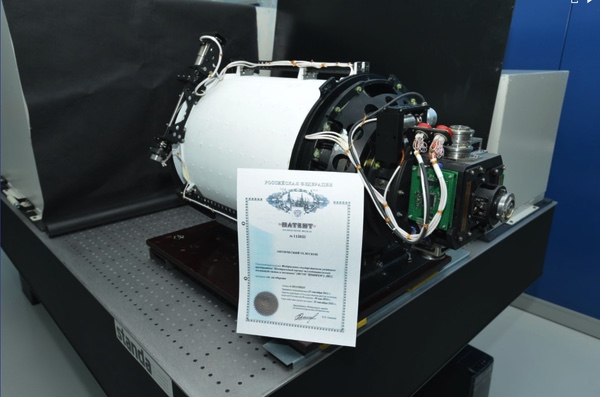Project Nivelir: Russia’s inspection satellites (part 2)by Bart Hendrickx
|
| Speaking somewhat later, NPO Lepton’s director Oleg Kazantsev, presumably unaware that video of the PhD defense would appear online, specifies the payload as a high-resolution camera flown on Kosmos-2519, the first 14F150 satellite. |
In his review of the dissertation, Kondranin named two hyperspectral cameras of NPO Lepton that Shcherbina had worked on and which had reached flight status by that time. One was a camera flown on Zond-PP, a small satellite of NPO Lavochkin based on the Karat platform that was launched in 2012, but failed after only several months in orbit. The other was a camera system called Pribor-GS, which must be the one flown on Kosmos-2519 and, presumably, subsequent 14F150 satellites as well.[4]
Pribor-GS had its roots in research on various types of remote sensing cameras ordered under Russia’s Federal Space Program for the period 2006–2015. This research project had the overall name Pribor (“instrument”), followed by an abbreviation denoting the specific type of camera, with “GS” standing for “hyperspectral”. By early 2011, NPO Lepton had been assigned to develop high-resolution (“VR” in Russian) hyperspectral cameras operating in three frequency bands:
- GS-VR-VD: visual band (0.4–0.9 microns) (70 channels)
- GS-VR-BIK: near-infrared band (0.9–1.7 microns) (40 channels)
- GS-VR-KIK: shortwave infrared band (2.0–2.4 microns) (20 channels)[5]
All three were eyed for installation on board a series of civilian remote sensing satellites called Obzor-O. These were to be built by the Progress Rocket and Space Center in Samara under a contract signed with Roscosmos on December 22, 2012. According to technical specifications for the satellite published at the time, the ground resolution of the complex would range from 25 meters in the visual band to 84 meters in the infrared band from an altitude of 700 kilometers. It was stated that the hyperspectral complex might be added to the main optical payload on the first two satellites, along with an infrared payload originally developed under Pribor-IK. However, a final decision on the inclusion of these add-on payloads would depend on the status of their development. The Obzor-O project was ultimately canceled in 2016 and it is not known if the hyperspectral payload was ever seriously considered to fly on these satellites.[6]
It would appear that Pribor-GS was incorporated into Nivelir sometime before Obzor-O got underway. Since it had to be optimized for both Earth remote sensing and satellite observations, it probably differed somewhat from the version later considered for Obzor-O. Further information is available only on the infrared part of the payload, for which NPO Lepton subcontracted work on the optical structure to the State Institute of Applied Optics (GIPO) in Kazan on December 1, 2011. Coincidentally or not, this was the same day that NPO Lavochkin received a contract for the 14F150 satellites from TsNIIKhM. The infrared camera is discussed in a handful of technical articles published by NPO Lepton and GIPO in 2014–2015 and also appears in a PhD dissertation of a GIPO researcher, where it is called GS-4.[7]
The infrared camera consists of two modules operating in the 0.9–1.7 micron and 2.0–2.4 micron range respectively. One such module is seen in the image below. Light enters the camera through an objective (nr. 1) consisting of three aspherical mirrors. The objective has an entrance pupil of 120 millimeters, a focal range of 250 millimeters and a field of view of 3.5 degrees. After passing through an entrance slit (2), the light enters the spectrometer (3), where a system of mirrors routes it first onto a diffraction grating (indicated with the Russian letter Д) and then onto the detector (4). The diffraction grating is the component that splits the light into its constituent wavelength components.
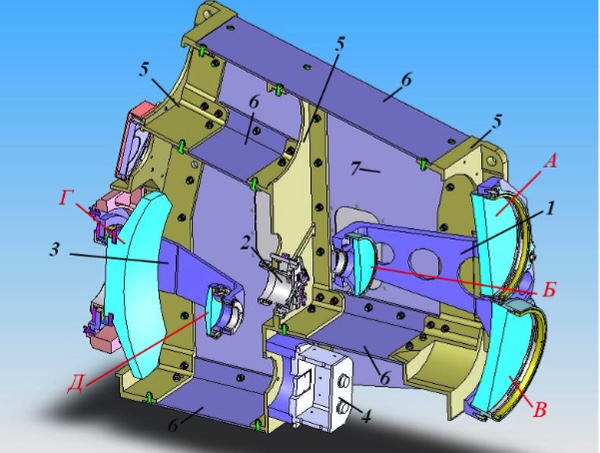 Module of the GS-4 infrared hyperspectrometer. Source |
The spatial resolution is given as at least 60 meters from a 500-kilometer orbit (which is roughly the altitude where most of the 14F150 satellites have operated) and the spectral resolution ranges from 10 to 50 nanometers. The camera relies on the pushbroom scanning technique, in which a linear array of detectors is used to capture a continuous strip or swath of the scene as the sensor moves along its path.
Presumably, the Pribor-GS hyperspectral payload flown on the Nivelir satellites is the same one described by Shcherbina in his 2014–2015 articles, even though he doesn’t identify it there as being hyperspectral. In the article, Shcherbina outlines some of the challenges posed by using one and the same camera to image objects on Earth and in space. The camera uses a CCD architecture known as interline transfer, which minimizes image smearing. When observing objects on Earth, it operates in a mode called “time delay integration,” a detector readout mode commonly used in remote sensing which allows continuous exposure of the observed object as it moves under the field of view of the camera. When imaging objects in space, it switches to “staring” or “frame” mode, using all its plane array detectors to focus on an individual target.
| The military’s interest in hyperspectral imaging of Earth is easier to explain. The superior spectral resolution of hyperspectral cameras is particularly useful for locating and tracking camouflaged military targets. |
The use of hyperspectral cameras for imaging space objects was discussed in a 2017 conference paper by a researcher of the Mozhaiskiy Military Space Academy who had already co-authored an article on hyperspectral cameras with a specialist of TsNIIKhM in 2010. It centers on the use of small satellites to observe space objects in the optical and infrared range of the spectrum in dozens or hundreds of narrow spectral channels to obtain images with high spatial and spectral resolution. It also examines the different imaging techniques required to observe objects during high-speed flybys and low-speed close-up inspections, two observation modes that have both been seen during the Nivelir missions. Unfortunately, only the abstracts and some excerpts from the paper are available, leaving many questions about the advantages of imaging satellites with hyperspectral cameras. There are no other known examples of such cameras being used for that particular purpose.[8]
The military’s interest in hyperspectral imaging of Earth is easier to explain. The superior spectral resolution of hyperspectral cameras is particularly useful for locating and tracking camouflaged military targets. Hyperspectral data can also help identify changes in terrain, which can be essential for military planning and navigation as well as revealing the presence of hidden tunnels or bunkers. Other uses include discrimination between real military assets and decoys and the detection of submarines and underwater mines. In addition to that, hyperspectral cameras can detect nuclear and chemical weapons production and storage facilities and are also capable of identifying airborne substances produced by chemical weapons.[9]
The latter applications were key goals for another hyperspectral payload that NPO Lepton described in a paper in 2015.[10] Identified only as the Hyperspectral Optical Complex (GOK), it would operate in five different frequency bands ranging from 0.4 microns (optical) to 12 microns (long-wavelength infrared). Aside from traditional remote sensing tasks, it would be used for less conventional objectives:
- monitoring of nuclear power plants, nuclear waste sites and other “potentially dangerous industrial facilities”
- studying the consequences of “technogenic catastrophes” caused by the release of radioactive and highly toxic substances
- monitoring areas affected by “terrorist attacks using nuclear, chemical and biological weapons”
- monitoring plantations of psychoactive plants
The article was written jointly with specialists of the Ministry of Defense’s “27th Scientific Center”, identified on the ministry’s website as “one of the leading Russian research institutes to ensure radiation, chemical and biological safety and to counter threats posed by the spread and use of chemical and biological weapons”. This description may obfuscate its true role. In 2021, the center was placed on the US sanctions list for being engaged itself in research on and testing of chemical weapons.
The joint work with NPO Lepton on a hyperspectral payload did not come out of the blue. One paper by the 27th Scientific Center published as early as 2010 discussed the possibility of monitoring what were euphemistically called “physiologically active substances” in the lower atmosphere with a spectrometer installed on a satellite in a 500-kilometer orbit. It was noted that spectral resolution was far more important for such observations than spatial resolution.[11]
Despite the fact that such observations could be an additional military goal for a hyperspectral camera, there is no evidence that the GOK payload went on to fly on the Nivelir satellites. The 2015 article characterized it only as “a promising payload” and gave no indication in what stage of development it was at the time. Some later publications involving the 27th Scientific Center suggest it was supposed to operate in conjunction with a forward-looking camera that would be able to determine if targets of interest are covered by clouds or not.
Whatever the design of Nivelir’s hyperspectral payload, another indication that it is indeed used for remote sensing purposes comes from a recent article in the in-house magazine of NPO Lavochkin, the manufacturer of the 14F150 satellites.[12] The article analyzes the orbits of currently operational US reconnaissance satellites, including the two (USA 326 and 314) that have most likely been targets of observation for Kosmos-2558 and 2576. Based on their orbits, the authors conclude that USA 314 and USA 326 most likely carry multispectral and hyperspectral cameras. Like other satellites carrying such payloads, they pass the descending node of their orbits at around noon local time, which minimizes the amount of shadows cast by objects and improves the signal-to-noise ratio of the images. The orbits, they claim, are also ideal for infrared imaging both in daytime and at night. Because of thermal inertia, artificial objects are colder or warmer than their surroundings at noon and at night respectively. By comparing images taken in daytime and at night, it becomes easier to identify such objects.
Whether USA 314 and 326 indeed carry such cameras remains open to discussion, but through their speculation on the nature of their payloads, the authors may have inadvertently revealed something about the motives for flying Kosmos-2558 and 2576 in orbits very similar to those of the American satellites. By doing so, the Russian satellites cannot only monitor the US satellites, but also benefit from the same advantages that these orbits offer for hyperspectral remote sensing.
The Nivelir satellites may also carry other payloads. Judging from the in-orbit picture of Kosmos-2558 (see part 1), the 14F150 parent satellites also have a payload resembling a telescope. This could well be another product of NPO Lepton. In a 2015 interview, director Oleg Kazantsev said that aside from star trackers and hyperspectral cameras, the company was involved in building space-based telescopes. Kazantsev added that work on mirrors for such telescopes (with diameters larger than 30 centimeters) had been outsourced to an industrial partner, the name of which he did not reveal.[13]
The partner in question is almost certainly an optical company named NPO Optika, which belongs to the Shvabe holding. Annual reports placed online by the company show that it began co-operating with NPO Lepton on space-based optical instruments in 2011, the same year that Nivelir was approved. One mentioned in several of the reports is called a “high-resolution panchromatic camera” (PKVR), although it is actually a telescope. According to the 2017 annual report, it has a Korsch optical system, which consists of three curved mirrors. The diameter of the primary mirror is given as both 32 and 33 centimeters (which, incidentally, is very close to the 30- centimeter diameter of the telescope carried by the American SBSS 1 satellite). An experimental version of the telescope was built in 2012 and flightworthy versions were ready by the middle of last decade.[14]
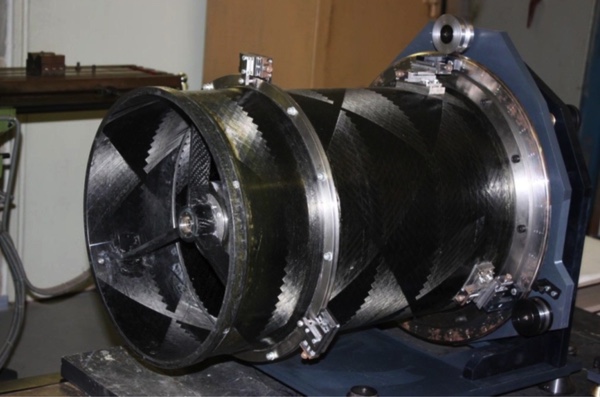 Experimental version of the PKVR telescope. Source: NPO Optika’s annual report for 2012. |
An instrument called PKVR also appears in an article published by NPO Optika in early 2019, which said it was intended for “Earth remote sensing for scientific and civilian purposes” and was being “successfully used” at the time. No Russian civilian satellites are known to have carried this instrument, meaning that the article was most likely referring to Kosmos-2519, the first 14F150 satellite, launched in 2017. A picture in the article shows the telescope’s objective from a different angle.[15] Strangely enough, it is described here as a catadioptric system, which, unlike the Korsch design, combines reflective optics (mirrors) and refractive optics (lenses).
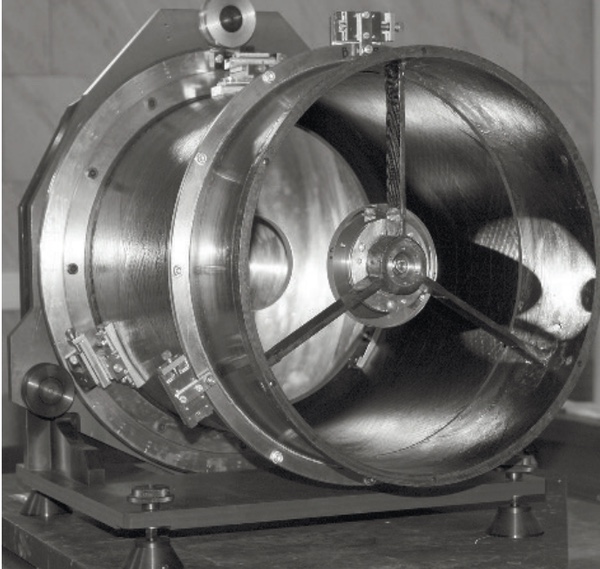 Another view of the PKVR telescope. Source |
Weighing around 30 kilograms and measuring 470x990 millimeters, it has an entrance pupil of 320 millimeters, a focal length of 2750 millimeters, and a field of view of 1.4 degrees. The aspheric surfaces of the primary and secondary mirror were shaped using a special automated process devised by NPO Optika. This is also discussed in a patent published by the company in 2017, which mentions its use to produce a 33-centimeter aspherical mirror made of a material called Sitall SO-115.[16] This is a crystalline glass-ceramic material developed back in the Soviet days which has been used for many Russian space-based mirrors. It is inferior in performance to such materials as silicon carbide and beryllium, but is relatively cheap and less susceptible to thermal expansion.
The same PKVR telescope is presumably also the focus of a patent published by TsNIIKhM in 2012.[17] Among the patent holders are NPO Lepton director Oleg Kazantsev as well as one person who can be linked to NPO Lavochkin, the manufacturer of the 14F150 satellites. The patent deals with an optical telescope that operates in “scanning mode” and is ideally suited for observing “moving objects” (possibly satellites). Two optical schemes were proposed for the telescope, one of which is shown below. Light passing through the objective (1) is split into three beams. One moves in a straight line and hits a detector array (4) in the optical axis of the objective. The two others are routed to two detector arrays (5 and 6) mounted perpendicular to the optical axis with the help of two mirrors (2 and 3) tilted at a 45-degree angle. In this way, three slightly overlapping images are obtained that are subsequently combined into a single image by an onboard computer. This imaging technique makes it possible to make uninterrupted observations of moving targets and poses less stringent requirements on the accuracy of the scanning system.
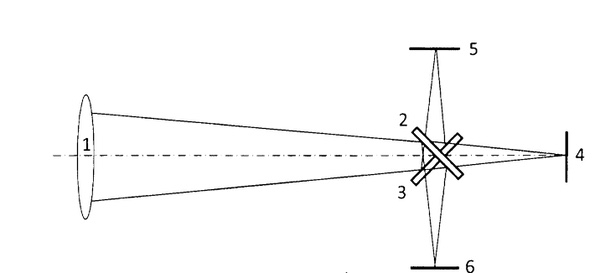 Optical scheme of a telescope described in a 2012 TsNIIKhM patent. Source |
The telescope described in the patent is seen in a picture that was available for some time on TsNIIKhM’s website (see the picture heading this article). The white-colored part is most likely the objective produced by NPO Optika (enclosed in a protective cover) and attached to it is the section carrying the three detector arrays and the two tilted mirors.
| All of those images just showed black space, except for one, where a bright object was visible at the edge of the image. The radio amateur speculated at the time it was the Sun, but it does not appear to have been bright enough for that. |
Like the Pribor-GS hyperspectral payload, the PKVR telescope may be used for both space surveillance and Earth remote sensing. The two payloads should complement each other, not only because they operate in different spectral ranges, but also because they have significantly different focal lengths and, hence, different spatial resolutions. Having a much larger focal length, the PKVR telescope should be capable of producing much more detailed images than the hyperspectral camera. There are some vague clues that NPO Lepton and NPO Optika may also have jointly designed a 1.1-meter mirror with adaptive optics. This reportedly could be used both for ground-based and space-based telescopes. Its current status is unknown.
Although TsNIIKhM seems to delegate most of the work on optical systems to specialized companies such as NPO Lepton and NPO Optika, it does play at least some role in their production. According to the institute’s website, it uses micro-electromechanical systems (MEMS) technology to manufacture “sensor systems for Earth remote sensing and monitoring space”. One aspect of this is the production of black coatings to minimize light scattering inside space-based optical systems. TsNIIKhM’s Nanotechnology Center has used picosecond lasers to apply the coatings to the inner surface of optical systems. Judging from older versions of TsNIIKhM’s website, this work has been done in collaboration with NPO Lepton since at least 2011, the year that Nivelir began.[18]
Payloads for the subsatellites
TsNIIKhM may also build imaging systems for Nivelir in-house, most likely for the subsatellites. Some articles published by the institute deal with a thermal imaging camera with an infrared detector known as a microbolometer. Infrared radiation striking such detectors changes their electrical resistance and this change is subsequently measured and processed into temperatures which can be used to create an image. Unlike other types of infrared detecting equipment, microbolometers do not require cooling, making it possible to reduce their size and mass.
Last decade, TsNIIKhM’s Nanotechnology Center worked on microbolometers under a contract awarded by a company called TsNII Tsiklon. This was part of a joint Russian-Belarusian project to develop new thermal imaging technology for both civilian and military purposes. While this does not appear to have been space-related, other work on microbolometers within TsNIIKhM clearly is. In 2013, TsNIIKhM researchers published an article on the potential use of microbolometer arrays to observe space debris. The authors referred to a similar device carried by an American cubesat called COPPER, which failed after its launch in 2012.[19]
In the past two years, TsNIIKhM has published more papers on space-based microbolometers for detecting and imaging other objects in space, notably when they are in Earth’s shadow. One article describes tests of such a microbolometer in a thermal vacuum chamber, indicating it may be a flight-rated instrument. Interestingly, its detector is identified as Bird XG, which is a large-format longwave infrared detector manufactured by an American company called SemiConductor Devices (SCD). This would indicate that TsNIIKhM has not yet mastered the technology to produce space-rated microbolometers all by itself. It is not known whether the thermal imaging camera carrying this microbolometer has already flown.[20]
At least one camera was on board Kosmos-2499, one of the early inspection satellites, launched piggyback on the Rokot booster in 2014. A Czech radio amateur was able to pick up imagery transmitted to the ground on a high-data-rate S-band downlink. All of those just showed black space, except for one, where a bright object was visible at the edge of the image. The radio amateur speculated at the time it was the Sun, but it does not appear to have been bright enough for that. Unless it was some image artifact, it could also have been the Briz-KM upper stage with which the satellite had rendezvoused in the weeks prior to the posting of the picture.[21]
 Image intercepted from Kosmos-2499. Source |
Ground support network
Nivelir’s ground support network has been the subject of several procurement and court documents published over the years. Two abbreviations seen in some of these are MNK and OZS.[22] They are not explained in the documents themselves, but also appear in a handful of articles on satellite ground support networks, where they are deciphered as “multifunctional ground complex” and “integrated ground station” respectively. These terms are also seen in a recently published TsNIIKhM patent, which relates them to both Earth remote sensing and observation of space objects, two key objectives of the Nivelir project.[23] The OZS stations are also mentioned on TsNIIKhM’s website, where they are not linked to any specific projects.
Tender documentation shows that TsNIIKhM was placed in overall charge of the ground network in 2011, the year that Nivelir got underway. At least some of the work has been subcontracted to ISS Reshetnev, best known as a manufacturer of communications satellites; NPO PM Razvitiye, a daughter company of ISS Reshetnev; and OOO Tekhnologii Radiosvyazi. The latter two are antenna manufacturers that co-operate on several projects.[24]
MNK is the overall name of the ground complex. It consists of three elements:
- a network of OZS ground stations
- a mission control center known as the Command and Information Center (KITs)
- a data processing center
The mission control center and the data processing center can be in the same place or in different places. The OZS stations are scattered across Russian territory and act as an interface between the satellites and both the mission control and data processing center. They forward commands from the mission control center to the satellites and telemetry and navigation data from the satellites back to mission control. This traffic takes place in the S-band, the uplink frequencies being between 2.025 and 2.120 gigahertz and the downlink frequencies between 2.200 and 2.300 gigahertz. In addition to that, the OZS stations receive imagery of both the Earth and space objects in the X-band (between 8.025 and 8.4 gigahertz) and subsequently relay it to the data processing center.
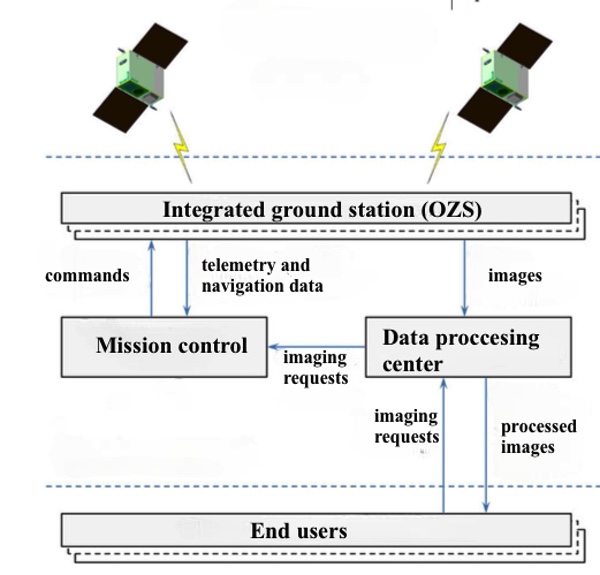 Schematic representation of the multifunctional ground complex (MNK) (adapted from a Russian drawing). Source |
The “O” in OZS (“integrated”) refers to the fact that the stations are capable of both sending commands to satellites and receiving data from them. This makes them unique in the Russian satellite ground support network, where those two functions are usually split between individual ground stations. According to one article, another advantage of the OZS stations is that they make it easier to prevent unauthorized access to information, something which is obviously very important for a sensitive project like Nivelir. This is because they communicate with only a single type of satellite instead of supporting a variety of satellites.[25]
Plans have also circulated for MNK ground complexes to support civilian Earth remote sensing satellites. Based on tender documents published in 2011, an MNK complex was eyed for the Resurs-P Earth observation satellites, but for some reason that idea was later abandoned. A similar complex is now planned for a constellation of remote sensing satellites being built by Gazprom under the name Smotr. Right now, though, Nivelir appears to be the only project relying on this particular ground infrastructure.
There is conflicting information on the number of currently functional OZS stations. According to a Russian space encyclopedia published in 2019, TsNIIKhM began operating two OZS stations in “experimental mode” in 2018 and these, along with a third one, were expected to become operational in 2020.[26] However, TsNIIKhM’s website claims only one is being operated at the present time.
Whatever the current status of the OZS stations, the planned location of three of them can be determined from a variety of online sources. All of them were supposed to be built on the territory of existing Russian space tracking facilities, namely OKIK-46 (Military Unit 14058) near Yeniseisk in Siberia, OKIK-6 (Military Unit 14086) near Vulkannyy on the Kamchatka peninsula, and OKIK-48 (Military Unit 34122) near Kudinovo in the Kaluga region. The Nivelir-related infrastructure at OKIK-46 and OKIK-6 is designated 1009/3 and 1009/4 respectively. Building contracts going back to at least late 2014 called for the modification of two existing buildings at both sites. Their exact relation to the OZS stations themselves is unknown. Plans for an OZS station at OKIK-48 are mentioned in just a single document in late 2016.[27]
Google Earth imagery shows possible signs of Nivelir-related construction work only at the site near Yeniseisk. A set of five parabolic antennas showed up there in early 2018, the same year that the first OZS stations are reported to have entered service. All of them have a diameter of about six meters, corresponding to that given in the TsNIIKhM patent. They are flanked by what appear to be one or more containers. The antennas could be S/X dual-band antennas designed jointly by OOO Tekhnologii Radiosvyazi and NPO PM Razvitiye in the middle of last decade.[28] Measuring six meters, they operate in exactly the frequencies required for the OZS stations. However, the TsNIIKhM patent says the antennas are installed on a hexapod mount, which is not what is seen in the only available ground-based picture of this antenna. Also, it is unclear why five of these antennas would be needed at a single location.
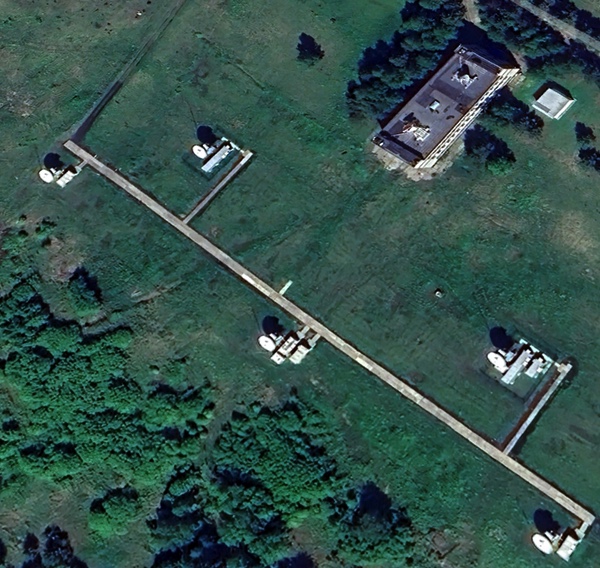 Five 6-meter antennas at the OKIK-46 space tracking site near Yeniseisk, Siberia. Source: Google Earth |
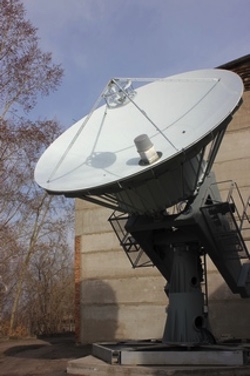 Six-meter S/X dual-band antenna built by OOO Tekhnologii Radiosvyazi and NPO PM Razvitiye. Source |
There is also a facility code-named 1009/5, which is described in some documents as the “information support segment” for both Nivelir and Burevestnik. It is situated some 60 kilometers southeast of Moscow in Noginsk-9, which is home to the headquarters of Russia’s space surveillance network. Judging from its name, it is intended to provide ballistic information on potential targets for Nivelir and Burevestnik satellites. Whether this also acts as a mission control and/or data processing center is unknown.
According to the TsNIIKhM patent, the OZS stations can be situated in remote locations and operate entirely automatically, requiring no personnel. One article indicates they can be mobile and even be deployed on ships.[29] Mobile ground stations for Nivelir do indeed seem to have been planned. In 2019, ISS Reshetnev was awarded two contracts for something called Nivelir-MNK-PPPS, with PPPS standing for “mobile ground station for receiving and transmitting information”. Part of that work was subcontracted to a company called AO MERK (Morelektroradiokomplekt) under the name Nivelir-MNK-PPPS-BMKT. In one court case involving AO MERK, BMKT is deciphered as a “modular container type unit”. The document mentions two such containers (BMKT 1 and 2), each equipped with humidity and temperature control systems. These could be similar to the containers seen in the imagery of OKIK-46 and house support equipment for the antennas.
AO MERK, which is now bankrupt, developed electronic systems for ships, raising the possibility that the containers were intended for sea-based OZS stations. These would make it possible to communicate with the satellites when they are out of range of Russian ground stations, giving them more flexibility in carrying out rendezvous and proximity operations with other satellites. It should be added, though, that AO MERK was also involved in ground-based projects, including a compact missile early warning system (designated MRIK VKO or 80P6) that includes containers to house support equipment.
Status and outlook
Two satellites believed to be of the 14F150 type, Kosmos-2558 and 2576, continue to circle the Earth. Launched in August 2022 and May 2024, they regularly perform orbit corrections, showing that both are still operational. They are in orbital planes close to those of the US reconnaissance satellites USA 326 and USA 314, but do stay at considerable distances from them, coming no closer than about 50 kilometers. Kosmos-2558 was orbited just about six months after USA 326, demonstrating that targets for the 14F150 satellites can be selected at relatively short notice.
| Kosmos-2558 and 2576 are space surveillance satellites that themselves pose no direct threat to the American satellites. What US officials have probably been concerned about is that, like their predecessors Kosmos-2519 and 2542, the two satellites may carry subsatellites armed with ASAT projectiles. |
US officials have on several occasions expressed concern over the maneuvers carried out by the Nivelir satellites. For instance, then-commander of US Space Command James Dickinson characterized the maneuvers of Kosmos-2558 as “irresponsible behavior”.[30] After the launch of Kosmos-2576, US Space Command assessed it to be it a likely counterspace weapon capable of attacking other satellites in low Earth orbit. Unlike the three test missions flown in 2017, 2019, and 2022, this one was believed to have been put into orbit “in an operational capacity.”[31]
In reality, Kosmos-2558 and 2576 are space surveillance satellites that themselves pose no direct threat to the American satellites. What US officials have probably been concerned about is that, like their predecessors Kosmos-2519 and 2542, the two satellites may carry subsatellites armed with ASAT projectiles. During the two earlier missions, these subsatellites exhibited significant maneuvering capability and fired their projectiles with Russian satellites flying in the vicinity as phantom targets or observation platforms. In other words, if Kosmos-2558 and 2576 have these subsatellites on board (which is not at all certain), they could theoretically destroy the American spy satellites.
Whether the subsatellites are on board or not, one must assume that the Russians are happy enough with the alarm triggered by their potential presence. Any actual attacks on the US satellites would be considered an act of war and could lead to the invocation of NATO’s Article 5. In 2021, this was rewritten to include the space domain, meaning that an attack on a NATO member’s space assets could incur a response from across the alliance. Russia may be even less inclined to consider such attacks now that relations with the US have begun to thaw under the Trump Administration. Coincidentally or not, a series of maneuvers by Kosmos-2576 this February reportedly moved it out of plane with USA 314, meaning it may by now be out of reach of the Russian satellite.[32]
According to one document, NPO Lavochkin was expected to produce five 14F150 satellites between 2017 and 2021.[33] Four of those are now believed to have been launched, leaving one in the inventory. It is possible, though, that more have been ordered since or that a modified version of the satellite is under development. One recent court document related to the 14F150 satellites referred to a satellite designated 14F168, which had not been identified earlier.[34]
There are also some indications that a follow-up government contract for Nivelir may have been signed in 2017. One procurement document involving the State Institute of Applied Optics (GIPO) linked an order of equipment both to the government contract that started Nivelir on September 30, 2011 (nr. 102/18/2011) and another one signed on November 13, 2017 (nr. 4Ts/2017). Another player in the latter contract is KB Tochmash, which has been involved in several anti-satellite projects (including Burevestnik). As part of that government contract, it was ordered to develop a “guided missile” referred to only as “Product R.”[35] Whether that is related to Nivelir remains uncertain.
Assuming Russia wants to continue space-based observations of US reconnaissance satellites, potential targets for future Nivelir satellites are USA 290 and USA 338. These are the only big US optical reconnaissance satellites launched in the past decade or so that have not yet been shadowed by 14F150 satellites. Unlike their counterparts, which are in Sun-synchronous orbits, they fly in orbits with an inclination of 73 degrees. In 2021, Russia’s Ministry of Defense ordered a study on the environmental impact of launches of Soyuz-2.1v rockets from Plesetsk into that particular inclination, which hasn’t been used since the late 1980s. This was possibly done with a view to placing Nivelir satellites into orbits that are co-planar with USA 290 and/or USA 338.[36]
Whether that will happen is somewhat uncertain though. The launch of a Soyuz-2.1v with the Kosmos-2581/2585/2583 satellites last February was widely reported to have been the last of the launch vehicle. The rocket’s first stage is powered by refurbished NK-33 engines that were originally built for the Soviet Union’s N-1 Moon rocket back in the 1960s and 1970s and this stockpile may now be depleted. If Soyuz-2.1v has indeed been abandoned (which has not yet been confirmed by official Russian sources), there are other ways of placing the 14F150 satellites and their possible successors into orbit. The fourth satellite in the series, Kosmos-2576, flew to space aboard the more powerful Soyuz-2.1b rocket, which used its extra payload capacity to deliver several other satellites to orbit. If no such passenger satellites are available, 14F150 satellites could also fly as dedicated payloads on the Angara-1.2 and Rokot-M launch vehicles, which have a payload capacity comparable to that of the Soyuz-2.1v.
The subsatellites may continue to hitch rides to space with 14F150 satellites or their successors. However, they could just as well be launched as independent payloads. In that case, a likely launch vehicle would be a small solid-fuel rocket that is under development for Nivelir’s sister project Burevestnik. Designated “293”, it is to be launched from the belly of a modified MiG-31BM fighter jet and consists of two stages and an upper stage.
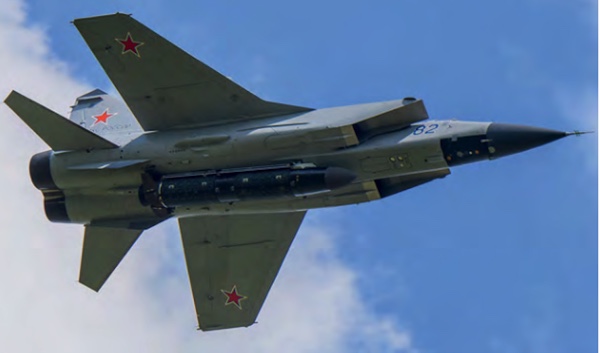 The ”293” rocket suspended under a MiG-31BM during test flights from Zhukovskiy air force base near Moscow. Source |
It is unlikely that the Burevestnik interceptors will be the rocket’s sole payloads. This is borne out by tender documentation placed online in 2019 for new construction work at the Plesetsk cosmodrome in support of both Nivelir and Burevestnik (as well as a third, unknown project known only as 14K177). This work was to include the adaptation of existing buildings and the construction of new ones. As can be deduced from the documentation, one of the new buildings was to be used for pre-launch processing of a solid-fuel rocket, most likely the air-launched “293” rocket.
There are no traces yet of the new building in the most recent Google Earth imagery of Plesetsk from September 2024. However, work is underway under another building contract that has been linked in documentation to Burevestnik. This is taking place at the cosmodrome’s airport and is seemingly intended to prepare it for take-offs and landings of the MiG-31BM fighter jets. One element that has been finished is a roughly one-kilometer extension to the airport’s runway. Also seen in satellite photography is a new hangar close to the runway extension that has just about the right size to house one or more MiG-31BM jets. There is no way of telling when the first space launch using a “293” rocket may take place.[37]
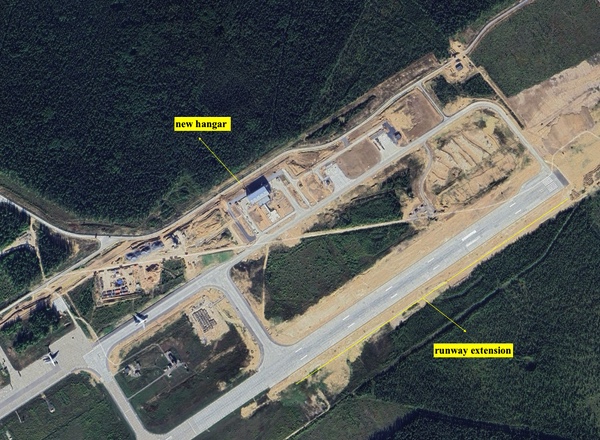 New infrastructure for the Burevestnik project at Plesetsk’s airport. Source: Google Earth |
Other space situational awareness missions
Russia may be developing several other types of satellites intended for space surveillance and/or orbital inspection. Among those may well be inspection satellites not unlike those flown under America’s Geosynchronous Space Situational Awareness Program (GSSAP). TsNIIKhM is known to be collaborating with ISS Reshetnev on a project involving a geostationary satellite designated 14F166. This is a fairly heavy satellite based on ISS Reshetnev’s Express-2000 platform which is presumably intended for military communications. TsNIIKhM’s role in the project may be to build subsatellites that will be deployed from the 14F166 satellites after they reach their destination in geostationary orbit. In other words, the 14F166 satellites would serve as a launch platform for small inspection satellites, in very much the same way that the 14F150 satellites act as parent satellites for the Nivelir subsatellites.
| Russia may be developing several other types of satellites intended for space surveillance and/or orbital inspection. Among those may well be inspection satellites not unlike those flown under America’s Geosynchronous Space Situational Awareness Program. |
There is some evidence that TsNIIKhM has indeed been working on small geostationary satellites that will be capable of conducting rendezvous and proximity operations using astronavigation techniques and machine vision systems. The 14F166 satellites will be launched from Plesetsk by Angara-A5 rockets with the Briz-KM upper stage. In early 2023, the launch of the first satellite was expected before the end of the year and it is now long overdue. It has been speculated that a 14F166 satellite will be the payload for an Angara-A5 expected to fly from Plesetsk in early June this year.[38]
One potential payload for a future space surveillance system was studied late last decade under a research project called Assistent (“assistant”). The idea was to use a combination of television cameras and laser systems to make three-dimensional images of objects in Earth orbit. The research was done jointly by NII Televideniya and an optical company called LOMO. Also involved was the Mozhaiskiy Military Space Academy, suggesting possible military applications. It is unclear though if the research led to a concrete mission proposal.[39] As mentioned in part 1, NII Televideniya also appears to have some role in Nivelir, but it is not known what exactly that is.
Finally, there are plans for a space-based segment of Russia’s civilian space surveillance network, which is known as ASPOS OKP (Automated System for the Warning of Hazardous Situations in Near-Earth Space). So far this consists only of a series of ground-based optical telescopes operated by Roscosmos in collaboration with TsNIImash (the space agency’s main R&D institute) and the Astronomical Scientific Center (AO ANTs). In late 2022, plans were announced for the modernization of ASPOS OKP under the name Mlechnyi Put (“Milky Way”). This includes the deployment of several space surveillance satellites to observe objects in low and geostationary orbits as well as potentially dangerous asteroids and comets. Payloads to observe the geostationary belt from satellites in Sun-synchronous orbits are being studied under the name Tsentavr (“Centaur”) by a company called NPK SPP. While conceptual studies are underway, the satellites are not expected to fly until the period 2031–2035.[40]
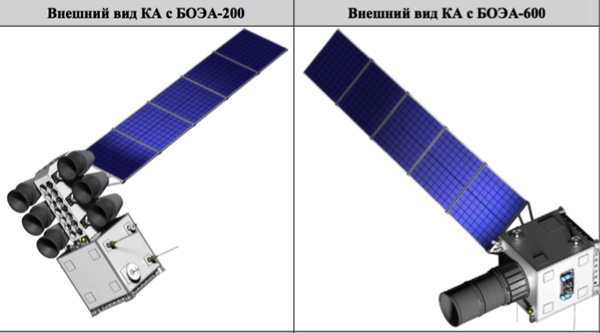 Possible payloads for satellites to observe the geostationary belt. Source |
References
- Presentation given in 2018, slide 19.
- Articles published in 2014 and 2015.
- Video of G. Shcherbina’s PhD dissertation defense (36:55-37:20 -55:00-55:35).
- Review of G. Shcherbina’s PhD dissertation.
- Post on Russian space forum (based on tender documentation), May 16, 2010 ; Article on space-based hyperspectral cameras published in 2013.
- Technical specifications for Obzor-O are in tender documentation published in 2012.
- Article published in 2014, pp. 41-46 ; Conference paper published in 2015, pp. 311-314 ; PhD dissertation published in 2019, pp. 274-275, 359.
- Conference paper presented in 2017.
- R. Uppal, Unlocking the spectrum: hyperspectral satellites and their remarkable applications, International Defense Security & Technology, 2023.
- Conference paper presented in 2015, pp. 107-108.
- Article published in 2010.
- Article published in 2024, pp. 18-29.
- Article published in 2015.
- NPO Optika’s annual reports can be downloaded here.
- Article published in 2019. NPO Optika did take part in the development of a telescope for a modernized version of the Aist-2D civilian remote sensing satellite. However, there are no signs it was involved in Aist-2D itself, which was launched in 2016. Aist-2D’s payload (Avrora) had different parameters than those given for PKVR.
- Patent published in 2017.
- Patent published in 2012.
- Patent published in 2012 ; Article published in 2020.
- Article published in 2013.
- Article published in 2022, pp. 264-269 ; Conference paper presented in 2023, pp. 74-76 ; Conference paper presented in 2024, pp. 71-73.
- Kosmos-2491/2499 page on the website of a Czech radio amateur ; Kosmos-2499 thread on the NASA Spaceflight Forum, post 38.
- See, for instance, tender publication published in September 2014.
- Patent published in 2024.
- Updates are given in annual reports of NPO PM Razvitiye, which can be downloaded here. NPO PM Razvitiye is given as a subcontractor to OOO Tekhnologii Radiosvyazi (OOO TRS) in the 2018 report.
- Article published in 2013.
- Russian encyclopedia on satellite ground control systems published by Stolichnaya Entsiklopedia in 2019 (not available online).
- Document published in 2016.
- Information published on the websites of OOO Tekhnologii Radiosvyazi and NPO PM Razvitiye.
- Article published in 2020, p. 18.
- Report aired by NBC News, August 10, 2022.
- S. Erwin, US Space Command ready for potential Russian satellite attack, general says, Space News, June 24, 2024.
- Space Threat Assessment 2025, p. 10.
- Report published by NPO Lavochkin in 2019, p. 14.
- Court documentation published in 2022.
- Tender documentation published in August 2019 (KB Tochmash), October 2019 (GIPO) and November 2019 (KB Tochmash).
- The environmental protection report for Soyuz-2.1v launches into 73° inclination orbits can be downloaded here.
- Updates on the Plesetsk construction work are in the Burevestnik thread on the NASA Spaceflight Forum.
- 14F166 thread on the NASA Spaceflight Forum ; TsNIIKhM thread on the NASA Spaceflight Forum , post 21.
- Articles published in 2019 and 2020. The research can be linked to the Assistent project through PhD dissertations published in 2019 and 2020 ( 1, 2).
- Report on “Milky Way” published in 2022 ; Conference paper published in 2022, pp. 50-53 ; Article published in 2022, pp. 32-34.
Note: we are now moderating comments. There will be a delay in posting comments and no guarantee that all submitted comments will be posted.
